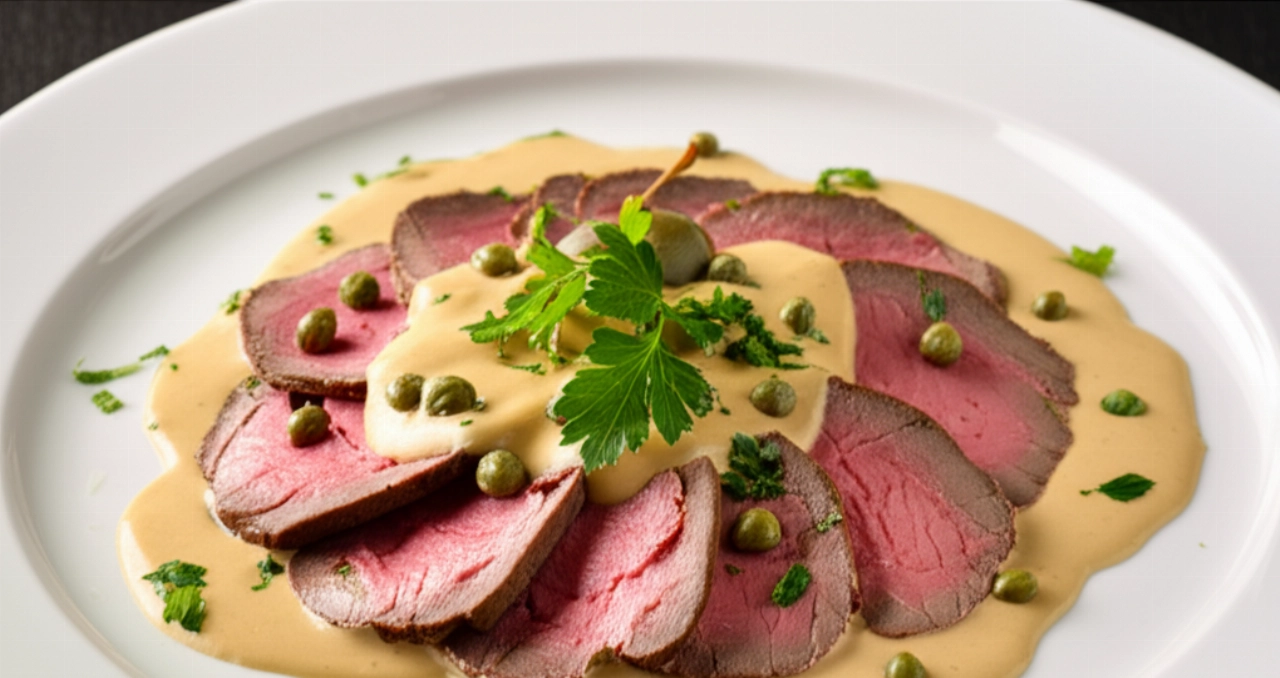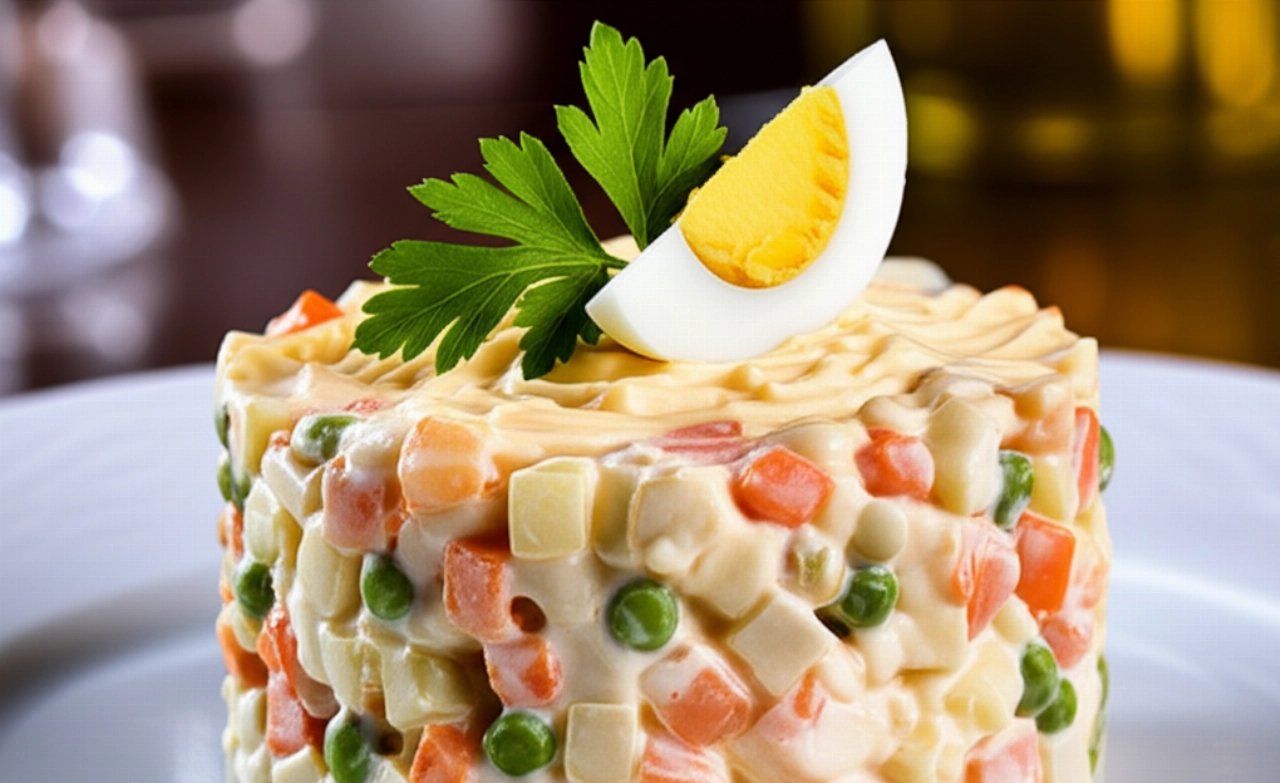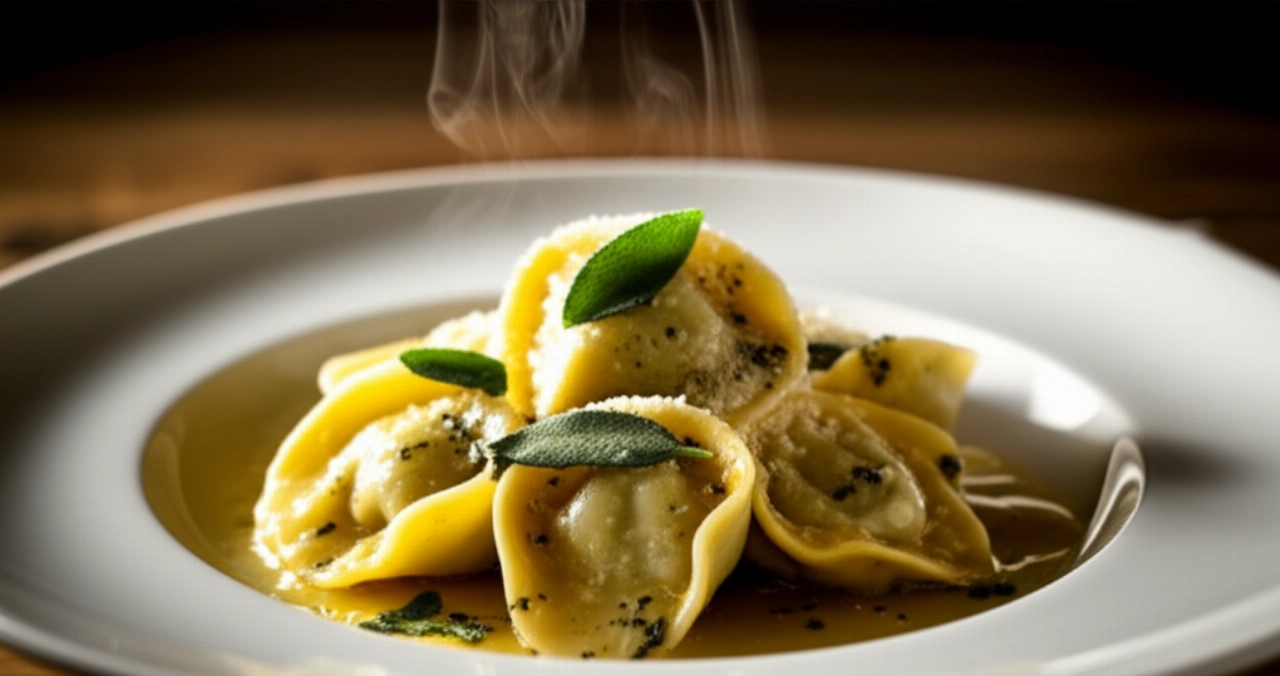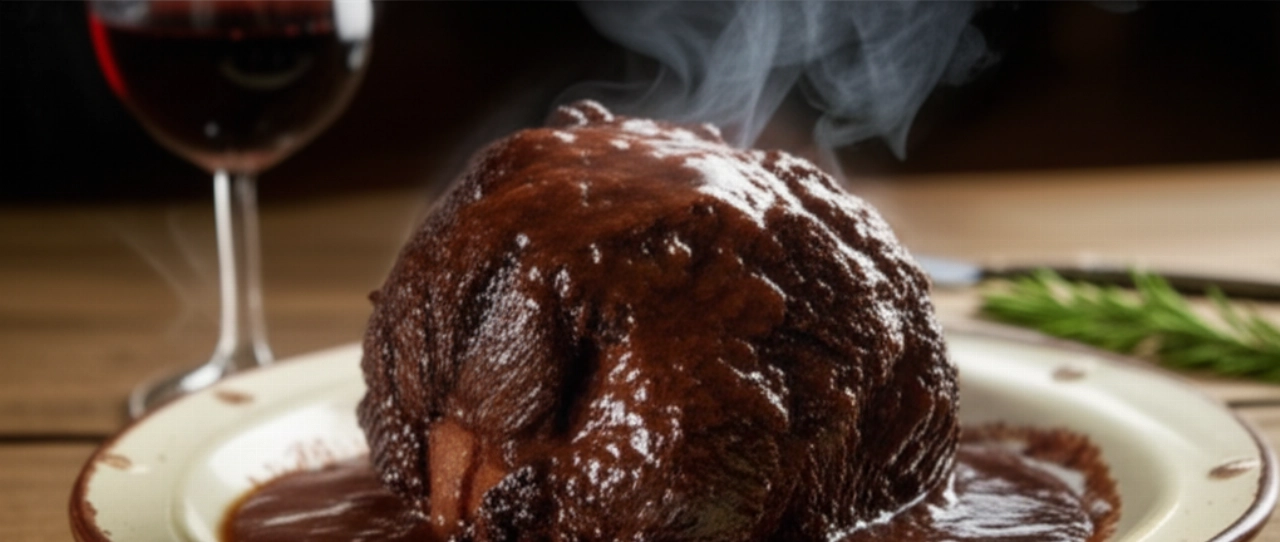Dreaming of serving a Vitello Tonnato that enchants your guests with its delicacy and authentic flavor, just like your Piedmontese grandmother's?
But how many times have you tasted one that was too dry, with a sauce that was too thick, or, worse, tasted 'pre-made'? Finding the original recipe, one that respects tradition and guarantees an impeccable result, can seem like a real challenge.
Make yourself comfortable. Here you won't just find a list of ingredients, but a complete guide, full of valuable tips and traditional tricks, to prepare the best and most authentic Vitello Tonnato you've ever tasted. Success is guaranteed, word from a 'guardian' of Italian cuisine!
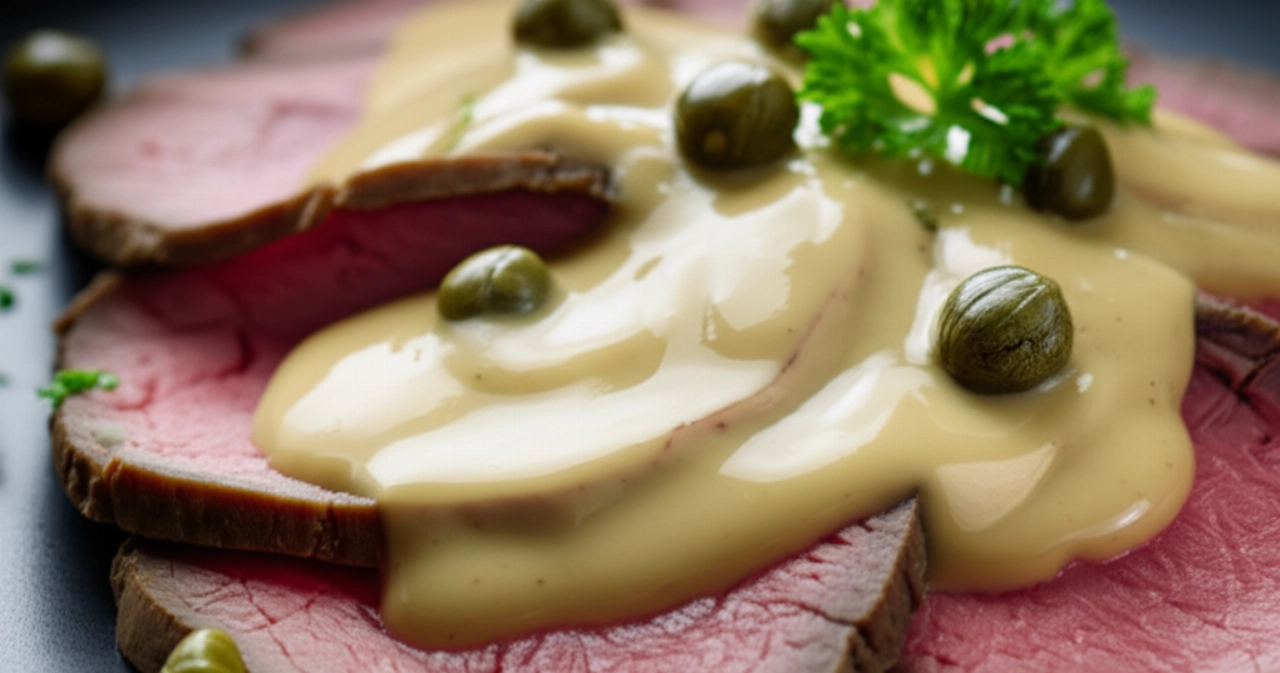
Ingredients for a Stand-Out Vitello Tonnato: The Choice That Makes the Difference
For a respectable Vitello Tonnato, the quality of the ingredients is the first, fundamental secret. It's not just a simple list, but a thoughtful selection that makes the difference between a good dish and a masterpiece.
- Veal Meat: Choose a piece of eye of round or topside (about 800g-1kg). These are lean and compact cuts, perfect for thin slicing and remaining tender after cooking. Avoid cuts that are too fatty or fibrous.
- Quality Oil-Packed Tuna: (200g drained) This is the heart of the sauce. Don't skimp on quality! Good tuna, preferably yellowfin or belly, will make a difference in terms of flavor and creaminess. Drain it well, but keep a little of its oil.
- Oil-Packed Anchovies: (4-5 fillets) They are the savory touch that balances the sweetness of the veal and the richness of the tuna. They must be of excellent quality; they will dissolve into the sauce.
- Salted Capers: (2 tablespoons) Rinse them well to remove excess salt. They provide an indispensable acidic and aromatic note.
- Vegetable Broth: (about 1 liter) If homemade, even better! It will be the cooking base for the meat and part of the sauce.
- Dry White Wine: (1/2 glass) To deglaze the meat and add depth of flavor.
- Vegetables for broth/cooking: Carrot, celery, onion (1 of each). They flavor the meat during cooking.
- Extra Virgin Olive Oil: (q.b. - as needed) A good, delicate oil, for browning the meat and finishing the sauce.
- Salt and Black Pepper: (q.b. - as needed) To adjust the flavor.

3 Common Mistakes in Vitello Tonnato (and How to Avoid Them)
Even the most experienced can fall into these traps. Knowing them will allow you to avoid them and ensure an impeccable result.
- Overcooking the Meat: The veal must remain tender and juicy, not stringy. Excessive cooking will make it dry and difficult to slice thinly. The secret: Check the internal temperature (60-65°C) or rely on the indicated cooking time, but always keep a close eye. Letting the meat rest in its broth is essential to rehydrate it.
- Using Low-Quality or Water-Packed Tuna: The tuna sauce is the heart of the dish. Poor quality tuna or, worse, water-packed tuna (which doesn't have the same consistency and flavor) will irrevocably compromise the result. The secret: Invest in good oil-packed tuna, preferably in glass. The difference will be abysmal.
- Adding Industrial Mayonnaise to the Sauce: The traditional Piedmontese recipe does not call for mayonnaise. Creaminess is achieved by emulsifying the tuna with the other ingredients and the cooking broth. Adding mayonnaise alters the authentic flavor and makes the sauce too heavy. The secret: Trust the traditional method. If you really want a richer consistency, you can add a hard-boiled egg yolk or a drizzle of quality extra virgin olive oil during blending, but never ready-made mayonnaise!

The Magic Touch: The Secret to a Velvety and Enveloping Tuna Sauce
My grandmother always said: “Vitello Tonnato is good if the meat is tender, but it's divine if the sauce makes you dream.” Her secret for a tuna sauce that melted in your mouth was very simple, yet brilliant: using the meat's cooking broth to emulsify the sauce. Not only did it give a deeper flavor linked to the veal, but it made it incredibly velvety and shiny, without the need for thickeners or mayonnaise. It was her unmistakable touch, what made her Vitello Tonnato legendary.
Let's Prepare Vitello Tonnato Together: The Step-by-Step Guide
Follow these steps carefully and success will be guaranteed. I will guide you as if I were right beside you in the kitchen!
Phase 1: Cooking the Meat
- Prepare the meat: Tie the eye of round or topside with kitchen twine to keep it compact during cooking and facilitate slicing.
- Sear the veal: In a large pot, heat a drizzle of extra virgin olive oil. Sear the meat on all sides over high heat until it forms a golden crust. This will seal in the juices.
- Add the aromatics: Add the coarsely chopped carrot, celery, and onion. Let them flavor for a few minutes.
- Deglaze and cook: Deglaze with white wine and let it evaporate completely. Then, cover the meat with hot vegetable broth. Bring to a boil, then reduce the heat to minimum, cover, and let it simmer gently for about 1 hour and 30 minutes - 2 hours, or until the meat is tender (depends on the size of the piece).
- Essential resting: Once cooked, turn off the heat and let the meat rest in its cooking broth for at least an hour, or even until it has completely cooled. This step is crucial to keep it juicy.
- Slice the meat: When the meat is cold, drain it from the broth (save it!) and slice it as thinly as possible. If you have a slicer, use it! Otherwise, a very sharp knife and a lot of patience.
Phase 2: Preparing the Tuna Sauce
- Prepare the ingredients: Drain the tuna well (reserving a tablespoon of its oil), rinse the capers, and desalt the anchovies.
- Blend everything: In a blender or food processor, combine the drained tuna, anchovy fillets, capers, and a ladleful of the meat's cooking broth (the one where the veal rested).
- Emulsify: Blend intermittently, gradually adding more cold cooking broth, until you get a smooth, homogeneous, and velvety sauce. The consistency should be that of a thick but fluid cream, able to coat the meat slices. If necessary, add a tablespoon of the tuna's oil for extra sheen.
- Adjust seasoning: Taste and, if necessary, adjust for salt and pepper. Remember that anchovies and capers are already salty.
Phase 3: Assembly and Resting
- Arrange the meat: On a serving platter, arrange the veal slices slightly overlapping.
- Cover with sauce: Generously cover the meat slices with the tuna sauce, ensuring each slice is well coated.
- Rest in the refrigerator: Cover the dish with plastic wrap and let the Vitello Tonnato rest in the refrigerator for at least 2-3 hours, or even better, overnight. This will allow the flavors to meld perfectly.
- Garnish: Before serving, you can garnish with a few whole capers, a sprig of fresh parsley, or a few anchovy fillets.
Tips and Frequently Asked Questions about Vitello Tonnato
Here are some of the most common questions I receive about Vitello Tonnato. I hope they are helpful!
Can I use a different cut of meat?
Eye of round or topside are the ideal cuts for their leanness and compactness, which allow for thin, tender slices. You can try with veal round, but be careful not to overcook it to prevent it from drying out.
Can I prepare the sauce in advance?
Absolutely! The tuna sauce can be prepared even a day in advance and stored in the refrigerator in an airtight container. In fact, the flavors will meld even better.
How do I store Vitello Tonnato?
Vitello Tonnato can be stored in the refrigerator, well covered with plastic wrap or in an airtight container, for 2-3 days. Make sure the meat is always well covered by the sauce to prevent it from drying out.
Can I freeze Vitello Tonnato?
I advise against freezing assembled Vitello Tonnato. Frozen and thawed meat might lose its tender texture, and the sauce might separate. However, you can freeze the cooked and sliced meat (without sauce) and the sauce separately. Thaw slowly in the refrigerator and then assemble.
Why isn't my tuna sauce velvety?
This can happen if you haven't blended enough or haven't added enough cooking broth. Continue blending, adding broth one tablespoon at a time, until you reach the desired consistency. Make sure the broth is cold.
There you have it! Now you hold not just a recipe, but the secret to bringing to the table a Vitello Tonnato that will speak of tradition, elegance, and, above all, your special touch.
Don't be afraid to challenge yourself. Cooking is a journey of discovery, and with this solid guide, your Vitello Tonnato will be a guaranteed success. Get ready to receive compliments!
Have you prepared your Vitello Tonnato following our tips? We're very curious to see your masterpiece! Leave a comment below, tell us about your experience, or share a photo on Instagram tagging @CercaRicette.it. If you loved this recipe, don't miss our guide for a perfect Piedmontese Green Sauce or another classic like Peppers with Bagna Cauda.
